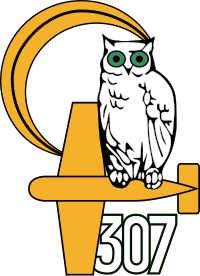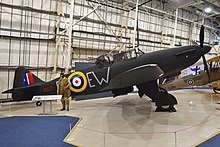No. 307 Polish Night Fighter Squadron
| No. 307 (Lwow) Squadron RAF | |
|---|---|
 307 Squadron Logo | |
| Active | 24 August 1940 – 2 January 1947 |
| Country | |
| Allegiance | |
| Branch | |
| Role | Night fighter |
| Size | squadron |
| Part of | RAF Fighter Command |
| Nickname(s) | Lwow Eagle-owls |
| Commanders | |
| Notable commanders | Stanisław Grodzicki |
| Insignia | |
| Squadron Codes | EW (August 1940 – January 1947) |
No. 307 (Polish) Squadron, also known as No. 307 (City of Lwów) Squadron (Polish: 307 Dywizjon Myśliwski Nocny "Lwowskich Puchaczy") was a Polish squadron formed in Great Britain as part of an agreement between the Polish Government in Exile and the United Kingdom in 1940. It was one of 15 squadrons of the Polish Air Force in exile that served alongside the Royal Air Force in World War II. It was the only Polish night fighter squadron in RAF service.[1] It was named after the Polish city of Lwów, and was nicknamed "Eagle Owls".
History

The nickname Lwowskie Puchacze (NOM) – "Lwów Eagle Owls" was chosen for the night fighter squadron, as the eagle owl is a nighttime avian predator that is present in Poland. The squadron inherited the traditions of the Polish pre-war 6th Aviation Regiment, that was stationed in Lwów (now Lviv), with a history dating back to the defence of Lwów and Galicia from invading Ukrainian forces in the Polish-Ukrainian War of 1918–1919.
After its formation in Blackpool on 24 August 1940,[2] No. 307 Squadron was assembled at RAF Kirton-in-Lindsey on 5 September 1940 as a night fighter unit, flying the Boulton Paul Defiant turret-fighter. It then took up residence at RAF Jurby, on the Isle of Man. The sole surviving example of the Boulton Paul Defiant, serial number N1671, served in the squadron and can be seen on display at the Royal Air Force Museum Cosford.
In August 1941 the squadron converted to Beaufighters which it flew until being re-equipped with Mosquitoes in December 1942.
Between April 1941 and April 1943 the squadron was based at RAF Clyst Honiton, now Exeter Airport, defending South West England from enemy night bombers.[3] The first Beaufighter victory was on 1 November 1941, when a crew shot down one Dornier Do 217 from II./KG 2 and damaged another (claimed as shot down).[4] That month, two more bombers were shot down and one damaged.[4] However, several of the squadron's aircraft were lost in crashes in the following months, mostly due to weather conditions or the unreliable engines of the Beaufighter Mk IIF variant.[5]
On 3/4 May 1942 when 40 Junkers Ju 88 bombers attacked Exeter as part of the Exeter Blitz of the Baedeker raids there were only three Polish No. 307 Squadron Beaufighters available to defend the city.[6] They managed to intercept and shoot down four of the German bombers that night (all confirmed kills).[6] That month, the squadron re-equipped with the improved Beaufighter Mk VIF.[7] In total, Beaufighter crews shot down fifteen bombers with three probables and six damaged; the last victory was the shooting down of a Do 217 on 24/25 September 1942.[8]
From 1943 the squadron was based at RAF Predannack, Cornwall, and was active as a night intruder unit over airfields in occupied France. This changed in January 1945, when its role was switched to bomber support, combating German night fighters. In 1945–46 it was based at RAF Horsham St Faith near Norwich. The squadron was disbanded on 2 January 1947[9] after the end of World War II.
Commanding officers
| From | To | Name | Notes |
|---|---|---|---|
| Sep 1940 | Mar 1941 | S/Ldr. George Charlie Tomlinson | British Officer |
| Sep 1940 | Oct 1940 | Kpt. Stanisław Pietraszkiewicz | Polish co-commander |
| Oct 1940 | Nov 1940 | Maj. Kazimierz Benz | Polish co-commander |
| Nov 1940 | Jun 1941 | Lt.Col. Stanisław Grodzicki | First as co-commander, later as Squadron Leader |
| Jun 1941 | Oct 1941 | Kpt. Jerzy Antonowicz | |
| Oct 1941 | Nov 1941 | Por. Maksymilian Lewandowski | temporary commander |
| Nov 1941 | Aug 1942 | Maj. Stanisław Brejniak | Wing Commander |
| Aug 1942 | Mar 1943 | Kpt. Jan Michałowski, VM, KW, DFC | Wing Commander |
| Mar 1943 | Apr 1943 | Kpt. Gerard Ranoszek | temporary commander |
| Apr 1943 | Jan 1944 | Maj. Jerzy Orzechowski | Wing Commander |
| Jan 1944 | May 1944 | Kpt. Maksymilian Lewandowski | Wing Commander |
| May 1944 | Mar 1945 | Kpt. Gerard Ranoszek | Wing Commander |
| Mar 1945 | Mar 1946 | Kpt. Stanisław Andrzejewski | Wing Commander |
| Mar 1946 | Jan 1947 | Kpt. Jerzy Damsz | Wing Commander |
Aircraft operated
| From | To | Aircraft | Version |
|---|---|---|---|
| 17 September 1940[13] | August 1941 | Boulton Paul Defiant | Mk.I |
| 14 August 1941 | May 1942 | Bristol Beaufighter | Mk.IIf |
| 5 May 1942 | February 1943 | Bristol Beaufighter | Mk.VIf |
| 21 December 1942 | January 1945 | de Havilland Mosquito | NF.II |
| 19 June 1943 | October 1943 | de Havilland Mosquito | NF.VI |
| 22 January 1944 | November 1944 | de Havilland Mosquito | NF.XII, NF.XIII |
| 24 October 1944 | January 1947 | de Havilland Mosquito | NF.30 |
Honors
On 15 November 2019, the Polish 307 night fighter squadron was honoured for defending the British city of Exeter from a German blitz campaign during the second World War. A Polish white-and-red flag flew over the city in the South West England honouring the pilots who prevented the complete destruction of Exeter in the 1942 Luftwaffe attack.[14]
See also
- MV Kerlogue neutral ship attacked
- Polish Air Forces in France and Great Britain
- Military history of Poland during World War II
- List of RAF squadrons
References
Notes
- ^ Gretzyngier 1998, p. 30.
- ^ a b c d pl:Dywizjon 307
- ^ Morris, Jonathan (14 November 2015). "The Eagle Owls Polish squadron who defended Exeter". BBC. Retrieved 10 July 2020.
- ^ a b Janowicz 2018, p.30–33
- ^ Janowicz 2018, p.33–33
- ^ a b Janowicz 2018, p.37–38
- ^ Janowicz 2018, p.39
- ^ Janowicz 2018, p.42–44
- ^ Lewis 1968, p.96
- ^ a b c Rawlings 1978, p. 394.
- ^ Halley 1988, p. 360.
- ^ Jefford 2001, p. 87.
- ^ Simpson, Andrew (2013). "Boulton Paul Defiant I N1671/837OM Museum Accession No.74/A/16" (PDF). RAF Museum. Retrieved 16 October 2015.
- ^ "British city honors Polish WWII pilots". Polskie Radio. Retrieved 15 November 2019.
Bibliography
- Delve, Ken, 1994. The Source Book of the RAF. Shrewsbury, UK: Airlife Publishing Ltd. ISBN 1-85310-451-5
- Gretzyngier, Robert, 1998. Polish Aces of World War 2, Botley, Oxford, UK: Osprey Publishing
- Halley, James J, 1988. The Squadrons of the Royal Air Force & Commonwealth, 1918–1988. Tonbridge, Kent, UK: Air Britain (Historians) Ltd. ISBN 0-85130-164-9
- Janowicz, Krzysztof. Polacy i Beaufightery. "Aeroplan" nr. 5-6/2018 (134–135) (in Polish)
- Jefford, Wing Commander CG, 2001. RAF Squadrons: a Comprehensive Record of the Movement and Equipment of all RAF Squadrons and their Antecedents since 1912. Shrewsbury, UK: Airlife Publishing Ltd. ISBN 1-84037-141-2
- Lewis, Peter, 1968 (1959) Squadron Histories, RFC, RNAS and RAF, Since 1912. London: Putnam. SBN 370-00022-6
- Rawlings, John DR, 1976 (1969). Fighter Squadrons of the RAF and their Aircraft. London: Macdonald and Jane's (Publishers) Ltd. ISBN 0-354-01028-X
External links
- "307 "City of Lwow" Polish Fighter Squadron". Archived from the original on 27 October 2009.
- "307 Dywizjon Myśliwski Nocny "Lwowski"". polishairforce.pl (in Polish). – historic photographs
- "No 307 (Lwow) Squadron". Air of Authority – A History of RAF Organisation.
- Hodyra, Piotr. "Personnel of the Polish Air Force in Great Britain 1940-1947".
